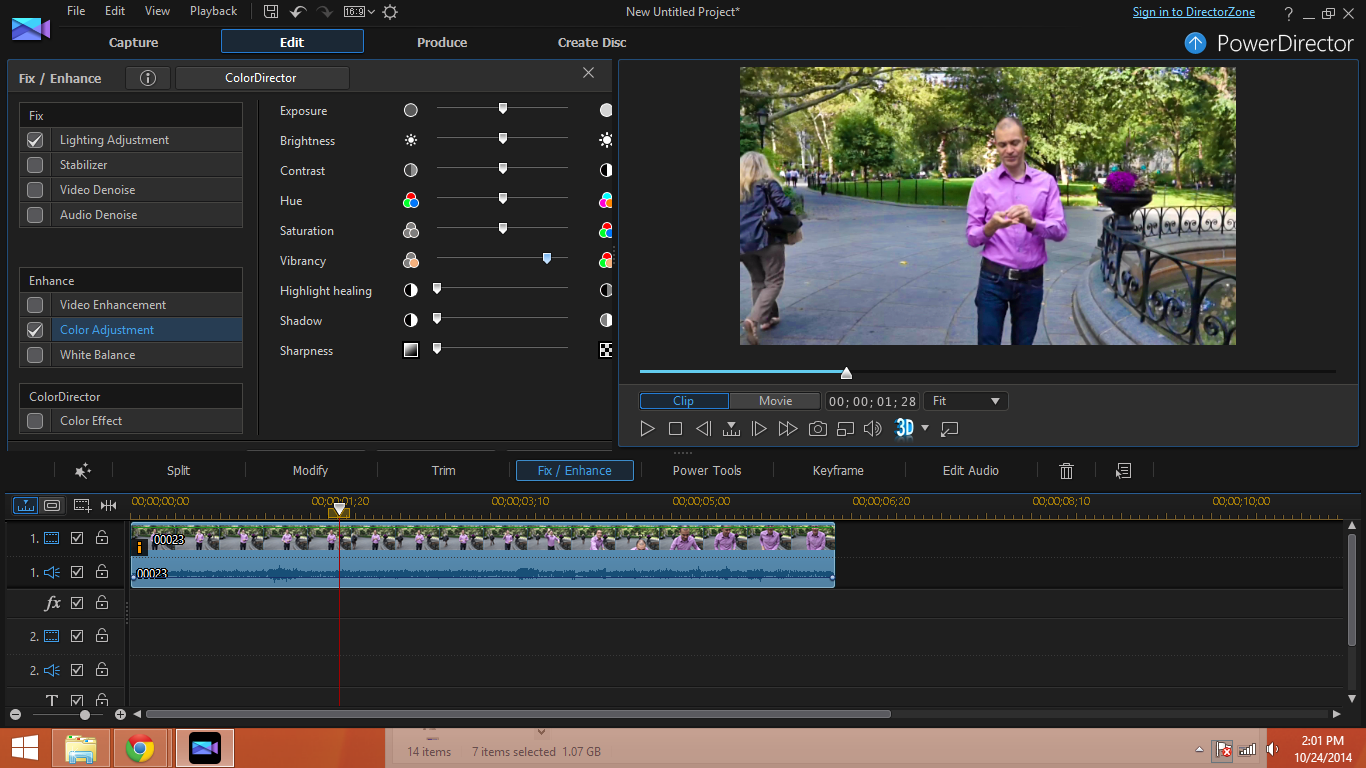A Guide To Inexpensive Video Editing Software
In the first two parts of our series, we only spent your money on hardware and the software was free. But sometimes you get what you pay for, so perhaps its time to spend a little.
CyberLink PowerDirector
PowerDirector from CyberLink is solid, superb and a little bit sexy. It’s quick to get around and remarkably speedy to render. It repays honest value. It’ll let you get your feet wet with 4K cutting.
But PowerDirector has a long-standing reputation for crashing and there’s lot’s of negative angst in the user community around CyberLink’s commonly crappy customer service.
A capable tool is nothing but a pain if it isn’t easy to use. PowerDirector is easy. It wants to make friends. It recognizes people (or at least faces) in your footage. It works generally the way your instincts tell you it should. Its tools fit your hand. Mostly.
At launch, the product gives you three tiers: a simple Slideshow Creator, a fast Easy Editor and its Full Feature Editor. If you like—and I know you will—you can ask PowerDirector to default to the Full Feature set. But try the Easy Editor a few times, even if just to watch the Themes feature at work. It’s a lot like iMovie in the Mac realm.
CyberLink has this marketing thing for magic: MagicMovie, MagicCut (auto-kills boring footage), MagicFix (guesses at lighting repair while stabilizing video and normalizing audio). I dislike the word in this context; it’s a little insulting to those of us who deal in evidence and engineering and science. But the stuff works well for your quick slash and burn editing jobs.
Stepping into the adult (non-magic) Full Editor, you get an appealing timeline that’s easy to get around. In most editors, the scaling and scrolling of your workspace, to show what you’re actually working on, is frequently a bit dicey. But PowerDirector does this extremely well. It's better, even, than a few big pro foundries like Avid Media Composer.
You’ll be keen on being able to drop multiple Ins and Outs on each source clip; very cool for documentarians laboring to stitch-up a narrative from fly-on-the-wall footage or extended interviews. Likewise, you can ask PowerDirector to Analyze Content for bits of action you may want to exclude (camera bumps and lighting blips) or specifically include (expressive people and dramatic pans or zooms). It’s not artificially intelligent editing, but in this you can grab a glimpse of that future.
Get Tom's Hardware's best news and in-depth reviews, straight to your inbox.
We old-fart editors tend to be very protective of our treasured timeline paradigm. But it’s not the only way to crochet a storyline. PowerDirector lets you edit using an alternate Storyboard mode. It’s as simple as dragging and dropping clips depicted by thumbnails. The trouble is, it’s only thumbnails, butt-cut (where the end of one clip abuts the start of the next) together. I'm guessing you’ll grow tired of that quickly and jump back on the timeline.
And on that timeline, you can wrangle up to 100 tracks (not that you’ll use them all). Drag to restack them. PowerDirector recently added support for MultiCam editing. Up to four sources, each on its own track, synchronize based on their audio. You can also use the more old-school approach of timecode synch, or even time-of-day if your cams are set-up accurately.
You can choose from among 150+ transitions and 125+ effects. A lot of these lack a professional level of subtlety and are missing some desirable control handles (although a few auto-calculate how much footage lap is need to make them work well). They are not bad at all for the price, but you can’t search them efficiently. Some were apparently written outside CyberLink and ported in, though there’s not (yet) an open plug-in architecture in PowerDirector.
The keyer works, if you’ve lit your green screen halfway well. But it won’t save your bacon if you haven’t.
There must have been a few sharp code-jockeys at work on PowerDirector. Effects and transitions preview very quickly, even on modestly-powered CPUs. You can see stabilization in close to actual time, so you can fuss with the cropping (to ensure you include all of your clip’s goodness). Just how CyberLink pulls this off is over my programming head. Much more importantly, it seems to be over the competition’s head as well. CyberLink marketing claims “the world fastest video editing engine” and, hardware equality assumed, I don’t doubt it.
I like to layer a lot and am frequently invoking picture-in-picture. Among other uses, this lets you use SD and HD footage at full resolution within a 4K project (important in this time of format transition). PowerDirector has some pic-in-pic game with a positioning coordinate system and the ability to animate PiP objects—you can even add motion blur. These will smoothly visualize without time-sucking render passes. That's more evidence of code elegance under the hood.
But that elegance was hard won. Many longtime users of PowerDirector have gotten used to feeling like crash test dummies. The title traditionally had a nasty habit of blowing up. Rev. 12, however, seems to be much more stable and, reportedly, a lot faster. Then again, the war stories I hear come from folks who are running it native in 64-bit on newer hardware with oodles of RAM.
Audio is handled by a price-tiered structure of companion routines and supplementary programs: Audio Room, Voice-Over Room, WaveEditor and (for a significant extra spend) the “round-trip-able” but standalone-priced digital audio workstation package AudioDirector. For scoring, MagicMusic churns out pre-licensed cues, but it too costs extra.
PowerDirector was an early facilitator of 3D stereoscopic video editing, in the game well before MAGIX or Sony. For the current release, CyberLink baked up some fresh 3D transitions effects and key-able font/title templates. 3D film-making has been around since 1922, but stuttered and sputtered often. Audience interest jumps in fits and starts with long stretches of ho-hum in between. There’s still a long way to go towards practicability and artistic subtlety in the 3D genre. That’s true in stereo for PowerDirector’s handling of 3D as well. But if you insist on poking people in the eye with sharp pointed sticks, please remember: working in 3D implies you need to more than double your drive capacity, and rendering generally slows down by at least half.
There’s a decent dojo of online ninja training at CyberLink, and more in the wild on YouTube. But if you still need answers, CyberLink supports you with the Director Zone, template sharing service and a user forum.
Like Starbucks, which offers four named-sizes of beverage each of which translates as “large,” CyberLink offers PowerDirector in Deluxe, Ultra, Ultimate and Ultimate Suite at ascending price/feature points.
Bottom line: If you can stomach Windows, you won't do better than PowerDirector, until you make the jump to all-pro programs
Current page: CyberLink PowerDirector
Prev Page A Guide To Inexpensive Video Editing Software Next Page Adobe Premiere Elements-
aebome It would help if you link to the other two articles in the series so we don't have to rummage through the site to see if we can find them. That's just basic.Reply -
beetlejuicegr unfortunately for me as a tv news director/ control i had the bad luck (you will see what i mean ) to learn montage on Final Cut on Macs. After that software, all the rest in pc are Crap! :( and i am a known anti-apple user ;/Reply -
Lord Darren In the interest of potential longterm planning, wouldn't it be prudent to familiaize oneself with Premiere from the get-go? In theory this should ease the learning curve if and when you make the jump to CS or CC.Reply -
sm_sum I checked the guide, it's very well written and very comprehensive. I came across free software that have good editing features. Maybe check them out: http://listoffreeware.com/list-best-free-video-editors/Reply


